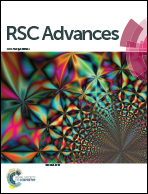Growth of ideal amorphous carbon films at low temperature by e-beam evaporation†
Abstract
Amorphous carbon (a-C) films were prepared by e-beam evaporation on silicon substrates. The effects of substrate temperature between room temperature and 600 °C were mainly studied. Raman spectroscopy, scanning electron microscopy, atomic force microscopy, UV-Vis-NIR and Hall-effect measurements were used to characterize the structure, morphology, roughness, transmittance and conductivity of a-C films, respectively. The results indicated the films obtained by e-beam evaporation were all graphite-like carbon films. The films deposited at 200 °C with a thickness of 75 nm presented the best performance with ID/IG of 4.50, FWHMG of 115.9 cm−1, an optical gap of 0.6 eV, a roughness of 0.825 nm and an electrical resistivity of 3.60 × 10−3 Ω cm. As the thickness reduced to about 8 nm while remaining at the same substrate temperature, the films still exhibited good structural quality, continuity and conductivity. SEM images from Ge/a-C/Si stacks and Ge/Si stacks confirmed the necessity of a-C buffer layer for smooth Ge film growth. Raman analysis of Ge films indicated that the crystalline quality of Ge films obtained from Ge/Si stacks was improved by inserting an a-C layer. The mechanism of a-C films as buffer layers was further explored by X-ray diffraction. The results suggested that a-C films with good properties prepared at such low temperature may be used as buffer layers for growing high quality Ge or GaAs films on Si.


 Please wait while we load your content...
Please wait while we load your content...